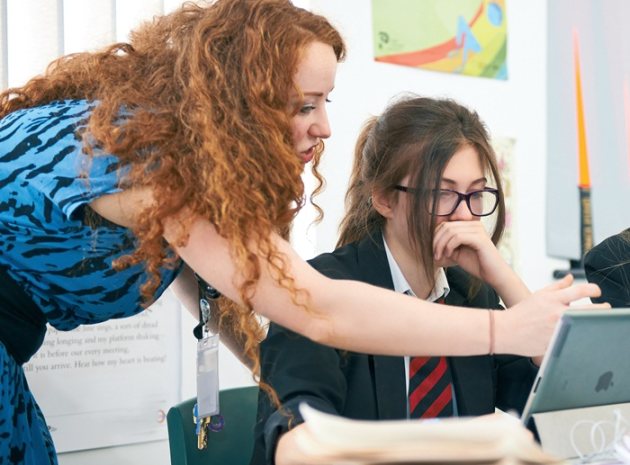As primary schools get to grips with the new computing curriculum, Pete Marshman considers a temporary – but very real – challenge for teachers of the subject at KS3 and beyond…
The introduction of a new curriculum means, amongst other things, that every child will now enjoy the benefits of learning about computing from day one of Reception. This is a wonderful opportunity - but the transition period, as we move to a point where a student starting secondary school will have experienced this from the start of his or her educational journey, will take some years. This throws up some challenges for educators, who must for the moment deliver the new curriculum to Y 7s who may only have been taught computing for two or three years.
Moreover, in my experience as regional coordinator for Computing At School, the implementation of the computing curriculum in primary schools is patchy. Some have embraced it wholeheartedly while others have no plans to cover the subject this year. Again, this has the potential to make teaching Year 7s a challenging experience, certainly in the short term.
So what are the issues and how can secondary teachers address them?
Cracking the coding
There is a misconception that computing merely involves programming or ‘coding’ and it’s quite likely some primary schools will focus too much on this area. It’s a vital strand of computing, but there is much more to the subject.
The concepts of computational thinking such as generalisation, algorithmic thinking, abstraction and decomposition are all part of the primary curriculum and enable students to think like computer scientists. These aren’t about coding per se. However, as many schools teach programming through graphical block programming languages such as Scratch or TouchDevelop pupils are missing out on learning these important skills that are needed to underpin their understanding of computing.
An important part of the computing curriculum is that children need to be able to apply computational thinking to a wide range of contexts. The need to have a deeper understanding of problem solving and not simply possess skills (such as coding) is a cornerstone of the curriculum.
Bridging the gap
Another important factor that secondary teachers will need to be prepared for is a much wider spread of ability than is typical in most subjects.
The removal of levels certainly makes assessment more interesting (!) but what’s important is to stay focused on computation thinking skills. A suitable baseline test that provides testing against computational concepts and not against specific software and programming skills is essential. These can be mapped to the progression pathways, which can be further mapped to the KS3 curriculum, this will give you a good understanding of the abilities of any new Year 7 students.
It is also worthwhile seating students so that they are able to work together collaboratively. They can support each other and push themselves as they see their peers in the classroom tackle more complex activities. This needs to be complemented with differentiation strategies to ensure that students who demonstrate significant gaps in knowledge and skills can be supported and, more importantly, can become more independent to ensure that they have the resilience to progress further in computing.
Putting it in context
Computing offers a great opportunity to be taught through other subjects and applied to real world problems and concepts. It is really important for teachers of Year 7 to ensure that lessons and schemes of work provide a cross-curricular approach whereby students are engaging in a discrete subject but are applying the skills and knowledge to familiar and interesting concepts. For example, students could engage in computing lessons that link to dance and art.
This can also be a useful way to smooth the transition from primary, where computing is more likely to be taught across the curriculum, to secondary - where it is a discrete subject.
I’ve had the opportunity to be involved in outreach work as an Advanced Skills Teacher for some time. This has enabled me to visit primary schools and see how computing is being taught. I’ve had the opportunity to teach Year 6 students in their own setting and this has offered me a valuable insight into how pupils will transition into Year 7. If you can build similar links this will really help in the next few transition years.
I’d also recommend helping primary teachers to find the support they need to teach the new computing curriculum effectively. This is a win-win for all. It benefits the individual teacher, ensures children receive high quality and effective teaching, and means that secondary teachers have Year 7 students able to work at the right level.
There are lots of networks and CPD resources that teachers can access. Computing At School is a grass roots teacher network, for example, and has just launched QuickStart Computing, which provides a comprehensive set of CPD resources for primary, and secondary teachers.
Secondary teachers also need to have a good understanding of the depth and breadth of the primary curriculum and how this can be built on and not revisited in Year 7. However, in the coming years I think it is likely that it will be necessary to teach students at KS3 aspects of the primary curriculum.
We really are in a process of transition at the moment. In seven years I think secondary school teachers will be teaching Year 7 students that have a solid understanding of computational thinking and can apply this sensibly in computing and across the curriculum.
By the time that is the case, I am confident that secondary school teachers will have learnt a great deal about how to teach computing, and in particular how to cope with wide ranges of ability. I also hope that working with their feeder primary schools during the transition will have led to new and exciting partnerships - and that we will all be ready for whatever the challenges of the 2020s will bring.
About the author
Pete Marshman is head of computer science at Park House School and regional coordinator for Computing At School.
A great start
QuickStart Computing is a CPD toolkit to help primary and secondary teachers to plan, teach and assess the new computing curriculum. It’s a free resource and teachers can use it to develop and run computing training in their school or cluster.
All primary and secondary schools have access to QuickStart Computing online. Resources include downloadable versions of the full teachers’ handbook, and lots of additional support including links to useful sites, online videos and interactive tools.
QuickStart Computing is produced by Computing At School - part of BCS, The Chartered Institute for IT, and funded by the Department for Education in association with Microsoft.










